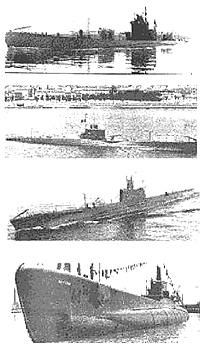 In the years between 1925 and 1940, the Regia Marina dedicated large resources to strengthening its submarine forces. This resulted in the deployment of 50 large submarines, 89 medium subs, 2 cargo submarines and 50 smaller boats. At the beginning of the war, Italy had a total of 117 submarines of which only 7 were obsolete.
In the years between 1925 and 1940, the Regia Marina dedicated large resources to strengthening its submarine forces. This resulted in the deployment of 50 large submarines, 89 medium subs, 2 cargo submarines and 50 smaller boats. At the beginning of the war, Italy had a total of 117 submarines of which only 7 were obsolete.
Top to Bottom:
Mameli Class
Argonauta (Type 600)
Foca
Cagni (Saint Bon Class)
The first medium-displacement class of submarines built were the four 830 ton MAMELI boats in 1929. In 1932, Italy began producing the 600 Class and the ANDROMEDA Class of only 650 tons. The same configuration was maintained on the SIRENA Class of 12 units, the PERLA Class of 10 units and the ADUA Class of 7 units. For the PLATINO Class of 13 units, displacement was increased to 710 tons.
From experience gained in the early days of the war, displacement of all units was increased with the TRITONE Class of 13 units attaining 905 tons. The first large submarines were the 4 units of the BALILLA Class. These double hull submarines of 1,405 tons displacement were first deployed in 1928. The later models were decreased to about 1,100 tons with the only exception of the 4 ocean going submarines of the SAINT BON Class and the two transport boats of the ROMLO Class.
All of the medium and large submarines were armed with a single deck gun, placed in front of the conning tower (sail). Some had a second gun emplacement on the tower itself or just abaft it. Torpedo launchers were installed bow and stern. Usually the medium size boats had two tubes astern and four forward. Some had a four and four configuration with the only exception of the BRAGADIN Class which had the stern tubes replaced with mine laying devices.
The large submarines were usually configured with four and four torpedo tube arrangement, with the exception of BALILLA which had only two stern tubes. MICA & FOCA, which were minelaying boats, were equipped with only two tubes installed under the after minelaying apparatus. The ocean going SAINT BON Class had six bow tubes and four stern tubes, although these were 450mm torpedoes (nicknamed Silurotti) instead of the standard 533mm. The ROMOLO Class of transport submarines had no tubes.
Standard propulsion was diesel engines for surface running, and electric motors for submerges operations. The SAINT BON and BALILLA Class boats had a third diesel engine attached to a dynamo used to produce electricity for surface navigation, thus providing for a low-speed, long-range capabilities.
Although in 1922 the Regia Marina had begun research on submerged operating using diesel engines, a device invented by Major Pericle Ferretti was never fully deployed. Even while collaborating with the Kriegsmarine, Italy never implemented the Dutch invented device known as the schnorkel, thus greatly impeding the performance of all its submarines.
Back to KTB # 159 Table of Contents
Back to KTB List of Issues
Back to MagWeb Master Magazine List
© Copyright 2001 by Harry Cooper, Sharkhunters International, Inc.
This article appears in MagWeb (Magazine Web) on the Internet World Wide Web. Other military history articles articles are available at http://www.magweb.com
Join Sharkhunters International, Inc.: PO Box 1539, Hernando, FL 34442, ph: 352-637-2917, fax: 352-637-6289, www.sharkhunters.com
